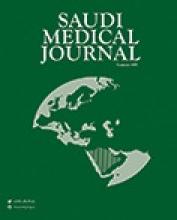Abstract
OBJECTIVE: To test the activity of tigecycline against bacterial isolates including multi-drug resistant (MDR) gram negative and gram positive organisms from intensive care patients.
METHODS: Clinically significant gram positive and MDR gram negative isolates from specimens of patients in the intensive care units of King Khalid University Hospital (KKUH), Riyadh, Kingdom of Saudi Arbia between November 1, 2006 and December 31, 2008 were tested against tigecycline by disc diffusion (DD) method. In some isolates, the minimal inhibitory concentration was carried out by E-test method. Some of the gram negative isolates, and gram positive isolates were tested using both methods. The study was approved by the hospital ethics committee.
RESULTS: All the 83 gram positive organisms tested by both DD and E-test were susceptible to tigecycline. Two hundred and fifty-four MDR gram negative isolates were tested for susceptibility to tigecycline. Of these 176 tested by DD, 159 (90%) were susceptible, 6 (3.4%) were resistant, and 11 (6.2%) were intermediately susceptible (data are not the same in table 3). From the 188 isolates tested by E-test, 140 (74.4%) were susceptible, 35 (18.6%) were resistant, and 13 (6.9%) showed intermediate susceptibility. For comparison between the methods, 109 isolates of the MDR gram negative organisms were tested by both E test and DD. The difference between the 2 methods was not significant.
CONCLUSION: Tigecycline was active against gram positive and most MDR gram negative isolates from patients in medical and surgical intensive cases in KKUH. There was no significant difference between the DD and E-test methods for susceptibility testing of tigecycline against these isolates.
- Copyright: © Saudi Medical Journal
This is an open-access article distributed under the terms of the Creative Commons Attribution-Noncommercial-Share Alike 3.0 Unported, which permits unrestricted use, distribution, and reproduction in any medium, provided the original work is properly cited.






